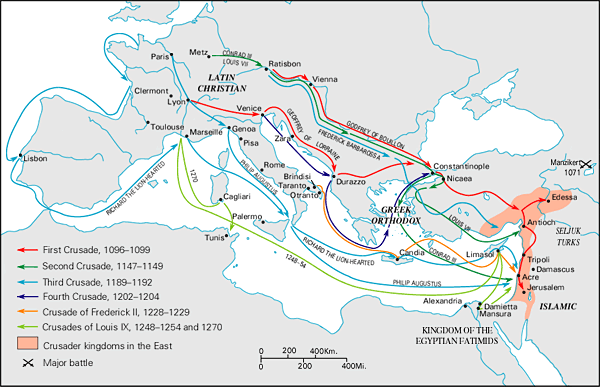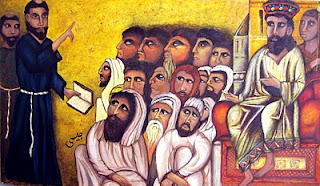Peace. It’s an elusive reality for our world today, a precious commodity, desired by everyone, yet how do we work towards it? Francis of Assisi as known as a man of peace. He lived for the poor, by living with them, all in his way to serve and worship the God that gave him life and animated his daily living. In this month of the Winter Olympics, celebration of Black History which recalls a vibrant nonviolent movement for peace and reconciliation, and continued talks about the “gearing down” of war efforts in Iraq and Afghanistan, peace continues to be as poignant as ever to our global village and our local contexts.
In the life of Francis we’re told that he went to Egypt to participate in the Crusades, specifically the 5th Crusade. Born to a wealthy merchant family in Medieval Italy, he would have been (and was) destined to be soldier, to seek his glory as a knight in battle, contests and romantic love. As a knight he would have dreamed of nothing greater than seeking to free the Holy Land from what they then called the Infidels who had taken it. Many were the young men in Francis’ situation that rallied and went to the Israel, Palestine and Egypt to seek glory for God – and for themselves.
Curiously Francis does in the end go participate in the Crusades, but in an unexpected way. “He sought to bring the Crusades to an end not by conquest but by conversion. Deeming it better to create Christians than to destroy Moslems.” (Chesterton, Chp 8) Motivated and animated by his desire to follow Christ and to live out his teachings, Francis (and his brothers) dreamed of going to the Holy Land to share the gospel in words as well as in actions caring for the poor, suffering and oppressed. He interpreted the Great Commission in Matthew 28:16-20
16 Now the eleven disciples went to Galilee, to the mountain to which Jesus had directed them. 17When they saw him, they worshipped him; but some doubted. 18And Jesus came and said to them, ‘All authority in heaven and on earth has been given to me. 19Go therefore and make disciples of all nations, baptizing them in the name of the Father and of the Son and of the Holy Spirit, 20and teaching them to obey everything that I have commanded you. And remember, I am with you always, to the end of the age.’
It was such imitation of the life of Christ that led to the dramatic and rapid growth of the community gathered around the example of Francis known as the Poor Brothers, or the Franciscans. The stories we have of him were retold after his death, most likely to help solidify the community that emerged from his example and which struggled in the century after his absence with their foundational commitment to poverty.
In 1219, Francis went to Egypt accompanied by other friars and hoping to convert the Sultan of Egypt or win martyrdom in the attempt. While that sounds fanatical to us today, it probably was then too – but it was also understood as the way to closest and most authentically live out an imitation of Christ – to die a similar death for the gospel. Did Francis go on a mission of evangelization and/or proselytism? Or was his trip to try to bring peace, to end the Crusades – a war based on religious motivations and a lack of inter-religious dialogue – through direct encounter, dialogue and relationship? Did he try to bring about peace through the Good News instead of with the edge of a sword? We don’t have any record of what Francis said about Islam, or practicing Muslims. There is no written proclamation of purpose in daring such a voyage and endeavor. And yet in a time of social upheaval, spiritual searching, a changing international political system and a world in which their was little to no inter-religious dialogue on a formal level, his story is striking and revelatory.
Francis, joined by other brothers left Italy with a Crusading army, eventually coming to the Egypt where a Crusader army had been encamped for over a year besieging the walled city of Damietta, near the Nile River. The Sultan, al-Kamil, a nephew of Saladin, had succeeded his father as Sultan of Egypt in 1218 and was encamped upstream of Damietta, unable to relieve it. A bloody and futile attack on the city was launched by the Christians on August 29, 1219, following which both sides agreed to a ceasefire which lasted four weeks. It was most probably during this interlude that Francis and his companion crossed the Saracen lines and were brought before the Sultan, remaining in his camp for a few days. The visit is reported in contemporary Crusader sources and in the earliest biographies of Francis, but they give no information about what transpired during the encounter beyond noting that the Sultan received Francis graciously and that Francis preached to the Saracens without effect, returning unharmed to the Crusader camp.
No contemporary Arab source mentions the visit. One detail, added by Bonaventure in the official life of Francis (written forty years after the event), concerns an alleged challenge by Francis offering trial-by-fire in order to prove the veracity of the Christian Gospel. Although Bonaventure does not suggest as much, subsequent biographies went further, claiming that a fire was kindled which Francis challenged the muslim wise-men to enter in a Elijah-esque contest to see who’s God was more powerful or true. The story recounts that while they would not do so, Francis unhesitatingly entered without suffering burns. Such an incident is depicted in the late 13th-century fresco cycle, attributed to Giotto, in the upper basilica at Assisi (pictured below)
According to some late sources, the Sultan gave Francis permission to visit the sacred places in the Holy Land and even to preach there. All that can safely be asserted is that Francis and his companion left the Crusader camp for Acre, from where they embarked for Italy in the latter half of 1220. Drawing on a 1267 sermon by Bonaventure, later sources report that the Sultan secretly converted or accepted a death-bed baptism as a result of the encounter with Francis. The Franciscan Order has been present in the Holy Land almost uninterruptedly since 1217 when Brother Elias arrived at Acre. [story redacted from the entry on Wikipedia]
Did Francis go on such a trip from his interpretation of the teachings of Jesus on peace, in particular John 14:23-29, Matthew 10:34-39 & Luke 4:14-21? At the birth of Jesus, who is to be called the Prince of Peace (Isaiah 9:6) the angels proclaim that peace has come in the world (Luke 2:14). In John 14 we hear Jesus talk of his peace that he brings into the world – which is not like the peace of the world. Matthew 10 asserts a problematic word in that the consequences of Jesus’ teachings will undoubtedly bring conflict, even if they are taught in nonviolence and peace. Luke 4 is the first recorded “sermon” of Jesus in which he comments upon the desire of God to give peace “the year of the Lord’s favor” to all people – in particular the poor, excluded, broken and marginalized.
The word Peace in Greek [eirene] in the Roman World meant a state of national tranquillity or an exemption from the rage and havoc of war. It was a peace between individuals, i.e. harmony, concord, security, safety, prosperity, felicity, (because peace and harmony make and keep things safe and prosperous). In Roman times (the world of Jesus) peace most pointed back to the Pax Romana – the peace – or cessation of the civil war accomplished by the rising power of Emperor Augustus, a legal security more about the absence of hostility than the presence of goodness.
In the New Testament, peace harkens back to the Old Testament Hebrew word for peace [Shalom] which is more about relationship than a state of being. Shalom is the full presence of well-being whether material or bodily, personal or communal. It’s not something that humans can agree to, but rather a gift that only God can give. It’s an eschatological word, pointing to the time outside of normal time, the sabbath of sabbaths or the 8th day – the destiny or perfection towards which God is bringing and will bring the world.
Jesus came to bring peace, to be our peace – it’s why we pass the peace in worship. But what does that mean for us? How are we called in turn to be peace-makers, to imitate the life of Christ? Should we take off on the next Boeing 747 for Kandhar or Kabul? What about the lack of peace in our own city of Oakland besieged by gun violence, drug abuse, gang activity, child prostitution and crime? Will we only have peace if we convert or proselytize those of other religions? What is peace for us now – what does God want for us – and how are we called to live for peace?
I’m confronted by my often blasé indifference to the need and hunger for peace in my own city. If I believe that Jesus is the Prince of Peace – who gives and is a peace that makes all things new, brings fullness and completion to us as human beings….then what am I doing with my life, my time, my energy, my gifts, my money to be an active peace-maker, reflecting that peace of Christ around me?
Questions for Reflection:
*What word, phrase or image strikes you in the Matthew 10 and John 14 passages?
*How does the story of Francis’ encounter with the Sultan touch your story, our story as a church?
*How do you see the Church: the community of those who follow Jesus of Nazareth – as being active peace-makers?
*How do you see yourself as being sent to proclaim the Kingdom of God come among us by building peace?
The story of Francis meeting the Sultan in other sources online:
- Listen to a round-table interview about Francis, and his life on Irish Radio. [Newstalk link]
- Listen/Read to a retelling of the story of Francis meeting the Sultan in the book God’s Troubadour: the Story of St. Francis of Assisi by Sophie Jewett [text of “With the Crusaders”] [audio retelling podcast to listen to – select number 3 from the list]
- Read Chapter 8 of Chesterton’s book on Francis, which details this encounter. “The Mirror of Christ” [LINK to Chapter.]


